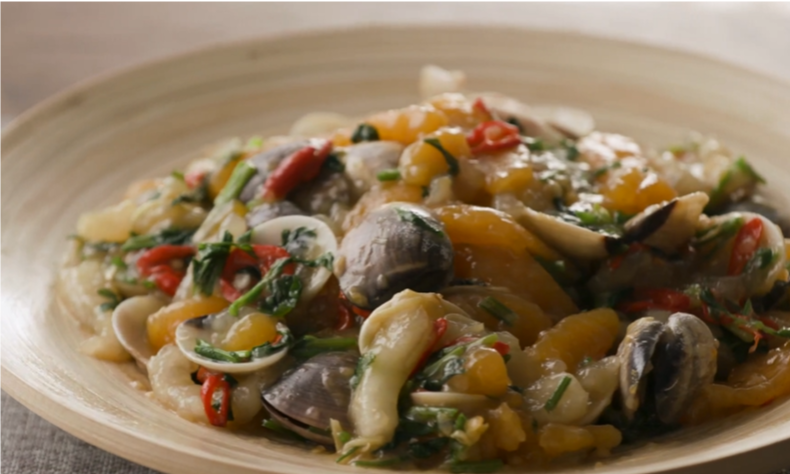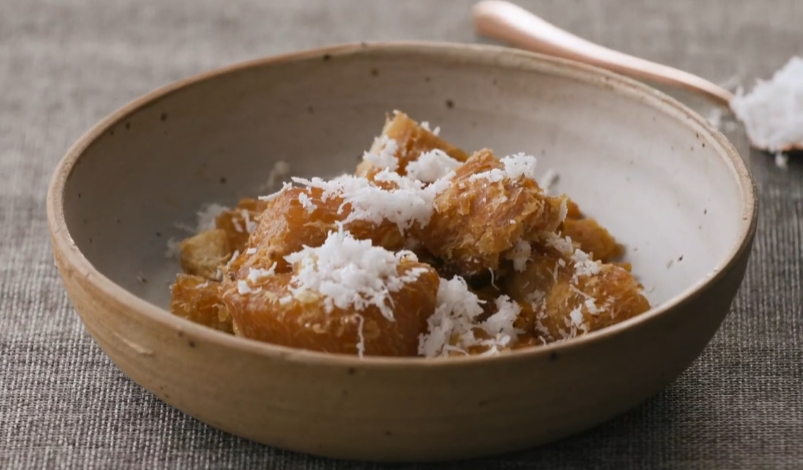Tapioca Tales
Can wartime food be delicious? Find out as cookbook author Lee Geok Boi whips up two dishes using only wartime ingredients.
Episode summary
Because of a rice shortage during the Japanese Occupation, people ate sweet potato and tapioca instead. Writer and cookbook author Lee Geok Boi shows us what the human imagination is capable of by taking these humble root vegetables and turning them into two delicious dishes, using only ingredients that were available in Japanese-occupied Singapore.

Recipes
Geok Boi’s recipes are inspired by tapioca noodles sold and distributed as rations during the Japanese Occupation, and memories of her father’s tapioca dessert. Tapioca, as well as sweet potato, replaced rice as a staple during the war, because it was an easy crop to cultivate and took only three months to mature.
Tapioca noodles
Makes about 500 g of noodles, serves 4
300 g tapioca*
150 g tapioca starch
1½ tsp. salt
fish sauce
chilli
ginger
clams
Chinese celery
*For sweet potato noodles, use 300 g of sweet potato instead of tapioca, and 300 g of tapioca starch instead of 150 g.
- In a small pot, mix the tapioca chunks with one rice bowl of water and bring it to a boil. Turn down the heat and simmer till tapioca is very tender. Add a little more water if necessary. Cool well, then mash the tapioca till fairly smooth, taking care to remove the tough string in the centre. The boiled tapioca can be mashed into the boiling water, if there is any left.
- In a mixing bowl, mix the mashed tapioca, tapioca starch and grated tapioca together with salt. Add enough coconut milk or water and knead well to form a medium-firm dough.
- Shape into rolls or flat cakes.
- Have ready a pot of boiling water. Drop the rolls or cakes into the boiling water.
- Boil till the cakes float up and turn translucent. It does not matter if cakes are not completely cooked through.
- Scoop out the cakes and leave them in a large bowl of cold water.
- Cut the cakes into preferred thickness of noodles.
- Heat oil in a wok and lightly fry the aromatics till fragrant.
- Add clams, fish sauce (or salt) and noodles to the wok.
- Add enough water for gravy and bring it to a boil to meld the flavours.
- Serve hot with sprinkling of chopped herbs.
Boiled tapioca with grated coconut
500 g tapioca, peeled and cut into chunks
200 g gula melaka or to taste
1/2 tsp. salt
500 ml water / thin coconut milk ( coconut milk optional)
- Put all ingredients into a pot and boil till tapioca chunks are done, fluffy and dryish.
- Add more water if needed. The amount of water needed will depend on the size of chunks.
- To check for doneness, stick a fork into the largest piece. It should break up.
- When little liquid is left, stir and turn over the tapioca frequently to prevent burning, though a few burnt spots are fragrant.
- To serve, sprinkle freshly grated coconut or top with a squeeze of coconut cream.

Related Articles
Wartime Victuals
Desperate times call for desperate measures. Lee Geok Boi trawls the oral history collection of the National Archives to document how people coped with the precious little food they had during the war.
Surviving the Japanese Occupation: War and Its Legacies
A revamped exhibition space opens at the old Ford Factory in Bukit Timah, marking the 75th anniversary of the fall of Singapore. Fiona Tan details its major highlights.
Grow More Food Campaign
The Grow More Food Campaign was started during the Japanese Occupation to place a check on inflation and prepare for an eventual blockade from enemy forces.
Bahau: A Utopia That Went Awry
The resettlement of Eurasian and Chinese Catholics in the jungles of Malaysia during World War II has been largely forgotten. Fiona Hodgkins chronicles its painful history.
Endau Settlement
Endau Settlement was a 300,000-acre agricultural settlement set up at Endau, in the Malayan state of Johor during the Japanese Occupation for Chinese settlers. It was considered the most successful self-sufficiency scheme initiated by the Japanese authorities to ease the food supply problem in Singapore.
Voices That Remain: Oral History Accounts of the Japanese Occupation
Oral history accounts of the Japanese Occupation take on added poignancy, says Mark Wong, as we mark the 75th anniversary of the Fall of Singapore.
Former Ford Factory
The Former Ford Factory, located at 351 Upper Bukit Timah Road, was the site where British forces officially surrendered Singapore to the Japanese on 15 February 1942 during World War II. In 2004, the site was handed over to the National Archives of Singapore (NAS).
Related Books
Lee Geok Boi, Syonan: Singapore under the Japanese 1942–1945 (Singapore: Singapore Heritage Society and Landmark Books, 2017).
Lee Geok Boi, The Syonan Years: Singapore under Japanese Rule 1942–1945 (Singapore: National Archives of Singapore and Epigram, 2005).
Lee Geok Boi, Syonan Singapore under the Japanese 1942–1945 (Singapore: Singapore Heritage Society, 1992).
Wong Hong Suen, Wartime Kitchen: Food and Eating in Singapore, 1942–1950 (Singapore: Editions Didier Millet and National Museum of Singapore, 2009).
Resources from the Archives
Ethel Rogers Mulvany, comp., Prisoners of War Cookbook: This is a Collection of Recipes Made by Starving Prisoners of War When They Were Interned in Changi Jail, Singapore (n.p. 1946). (From National Archives of Singapore accession no. 29/2005)

